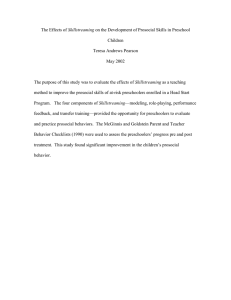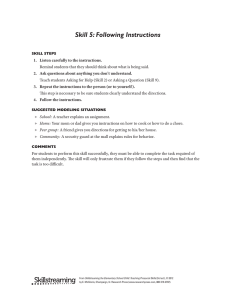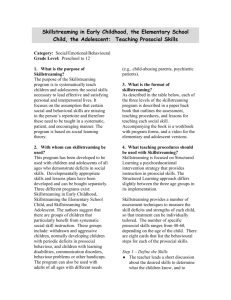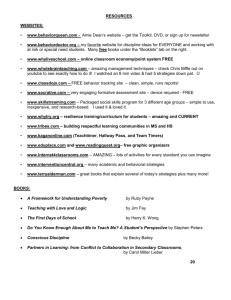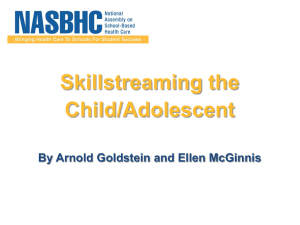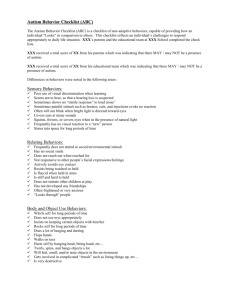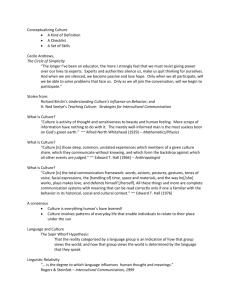How to use functional analysis for selecting skills for skillstreaming
advertisement
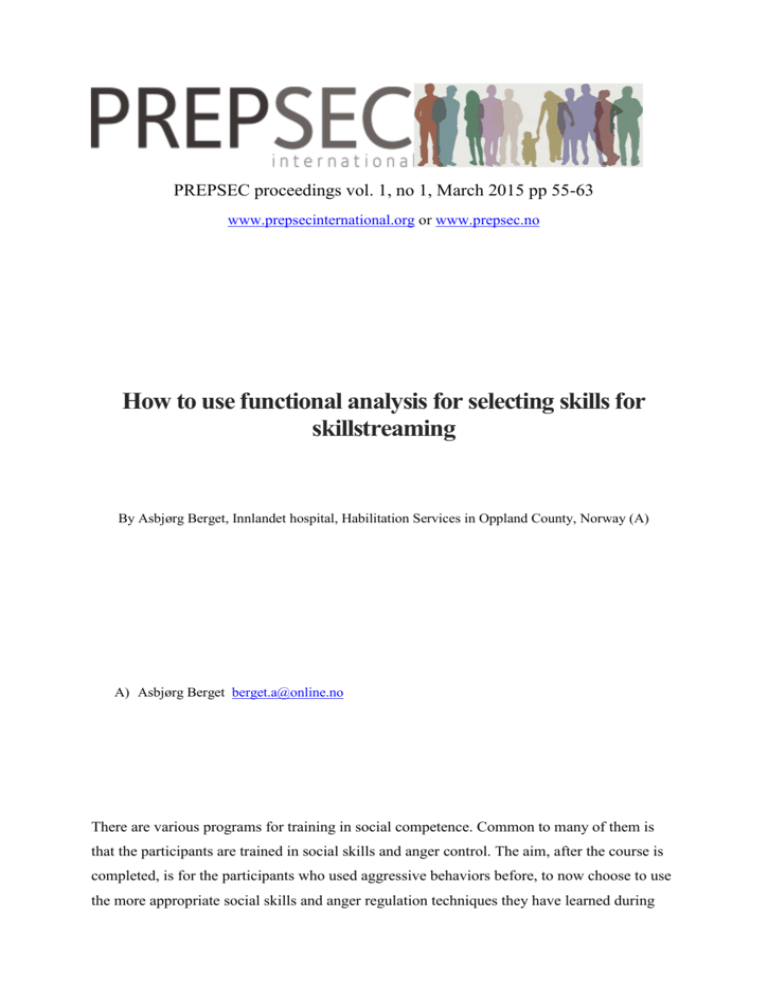
PREPSEC proceedings vol. 1, no 1, March 2015 pp 55-63 www.prepsecinternational.org or www.prepsec.no How to use functional analysis for selecting skills for skillstreaming By Asbjørg Berget, Innlandet hospital, Habilitation Services in Oppland County, Norway (A) A) Asbjørg Berget berget.a@online.no There are various programs for training in social competence. Common to many of them is that the participants are trained in social skills and anger control. The aim, after the course is completed, is for the participants who used aggressive behaviors before, to now choose to use the more appropriate social skills and anger regulation techniques they have learned during the training. Because these programs are being used for different target groups, adjustments to the implementation are made in consideration of the needs of the group one is training. For students with learning disabilities it is important to take sufficient additional time to adapt the training, as well as to assure the quality and relevancy of the skills the student is being taught. This is especially important for students with mental disabilities and autism, as they often need a lot of training to integrate new skills. This article addresses how the use of functional analysis can aid in applying the appropriate selection of skills. Introduction An important step in the preparations for Skillstreaming is the selection of which social skills will be a part of the training. When planning an interpersonal social skill program it is recommended to use a Skillstreaming checklist and general observations of the trainees to select skills (Goldstein, Glick et al. 1998). There are checklists that map age-appropriate skills and different versions for preschoolers, schoolchildren and adolescents/adults (McGinnis 2011; McGinnis 2011; McGinnis 2012). In those checklists, a score from 1-5 is recorded dependent on how often (Almost never, seldom, sometimes, often, almost always) the student uses a skill. It is recommended that a variety of people fill out the checklist, so that the collected data is more reliable. Because of these different versions of the checklists (students, teachers and parents), trainees’ proficiency in the same skills are mapped regardless of the informant. In addition to the checklist, it is recommended that observations of the student be made prior to the training. Observations can be used to gain a better insight into the student’s strengths and challenges. These observations can therefore allow for better preparation in order to meet the needs of the student. This is especially advantageous if the observers are the same persons who will conduct the training. Then they will have a good knowledge of the students, as well as being able to observe the student over time (Goldstein, Glick et al. 1998). A more structured form of observation can happen with the help of functional analysis. Functional analysis uses a selection of methods to map problem behavior. The term functional analysis refers to proving a functional connection between events in the environment and behavior (Skinner 1953). Normally you divide functional analysis into three categories: Indirect, descriptive and experimental analyses. Some claim that the term functional analysis can only be used when experimental demonstrations are used, and that indirect and descriptive analyses should rather be referred to as functional assessments (Beavers and Iwata 2014). Others claim that functional analysis should be a broad term that incorporates all means to find reasons for problem behavior with the help of behavioral principles (Holden 2013). Indirect functional analysis is analysis based on information obtained with structured tools as, for example, MAS (Durand 1990) or more informal interviews of the person and/or someone close. Descriptive functional analysis involves direct observations of the person in his or her natural environment. An Antecedent (Action) Behavior Consequence (ABC) chart is used to structure the situation. An ABC-chart records an Action or the Antecedent stimulus events, the Behavioral response and the Consequent stimulus events (Bijou, Peterson et al. 1968). In practice, it often happens that a parent, teacher or another close person fills out the form during or immediately after the episode has happened. The supervisors, or others with competence in behavioral management, review the charts together with those who have filled them out. You might say that this becomes a form of interview or indirect functional analysis. The difference is based on the information from the continuous reports, rather than a more general evaluation of what has happened. Experimental functional analysis involves a systematic manipulation of the environment to test which of the hypotheses causes the problem behavior. This analysis can prove or demonstrate under which conditions the behavior is maintained (Cooper, Heron et al. 2007). Selection of skills Initiating skillstreaming is often based on the needs of individual students or a small group of students, who are believed to show behaviors that require treatment. In this way much information about the student and his/her problem behavior has already been established. The problem behaviors that usually require training in social competence are behaviors that we collectively refer to as aggression, but often we can also see that there are other types of challenges that lead to the student being offered skillstreaming. It could be that the student is introverted, has difficulty making friends or is part of a high-risk group that suggests intervention to prevent further development of undesirable behaviors. When working with this group, students have a common need to enhance their social skills. Beyond that, they often have different needs that require individual adjustments. To achieve appropriate adjustments, reliable information about the student is required. Gathering information by using functional analysis could provide a good overview of which skills the student needs to practice and internalize. One way to do this is to let someone close to the student fill out the checklist included that is provided with the skillstreaming program (Goldstein, Glick et al. 1998). The checklist should be completed by as many as possible, but the participants should have good knowledge of the student. For children and young people, parents, siblings and teachers can be good informants. For adults with disabilities, often staff in residential services or day centers can be good informants. In addition to how often they use different skills, one also needs information about the problem behavior. This can be done using functional analysis in different ways. One way to do that is by using the ABC chart (Figure 1). It is advantageous if the same people, who have already filled out the checklist, do this. Time Antecedent or Action Behavioral Response Consequence Figure 1. Example of an ABC-chart. Prior to using the ABC chart, you must have an idea about which episodes you will include in the mapping. Typically, you define the responses or behaviors to be included. You agree on one or more behaviors to be recorded each time it occurs. Before doing this, it may be appropriate that the persons requested to do the recording are asked to describe as accurately as possible the challenges they believe the student has, and that they want the trainee to get help to resolve. In this way, you will be able to gather information by different people who see the student in different environments. After the selected close person has filled out the chart, he or she sums up the information he/she has gathered. One way of doing this is by having all of those who have filled out the chart sit together and summarize the results. Often you will see big similarities between the occurrences documented. With this information as a starting point, it is possible to make hypotheses about the functions of the different behaviors and begin to understand why the student does this behavior. After you have made a hypothesis about why the student shows a certain type of behavior in a situation, you can start the selection of which skills to teach. These social skills will replace the previously unwanted ways to solve the situation. To achieve this you have to select skills that will lead to the same results or consequence, which the student has gained before, by using the unwanted strategies. They must have the same function as the problem behavior. This means that if the behavior earlier made the student receive benefit, the student shall remain receiving the same benefits, but now dependent on the use of social skills. In the same way this should be true when tasks or activities appear which he has earlier escaped from by using the problem behavior, but now are dependent on the more appropriate use of social skills. After completing this, you can summarize the information from the checklist. If you see students who receive a low score on a skill you consider that they need, this will be a good indication that the skill should be taught. In other cases, one can see that the student has a high score on a skill, but fails to use it in a few specific situations. When this occurs, you will need to think that the student needs a different form of training. This can take the form of training in social perception and/or anger regulation, or you can treat the behavior by making changes in the reinforcement conditions (student’s environment). An example John is 7 years old and is in school. Academically he works relatively well and he has many interests. Since kindergarten there has been one worry connected to John’s behavior with his same-aged friends and his younger siblings. John has friends he likes to play with, but the play often ends in conflict. Often conflict even appears before the play has started. The school maintains that John needs training in social skills and wishes to offer him a place in a skillstreaming group. Prior to the training a survey of checklists is given. The survey is done by having both parents (independent of each other), grandmother and two teachers fill out the checklist of social skills of the Elementary School version (McGinnis 2012). Parents and grandmother fill out the parent’s edition, the teachers fill out the teacher edition. This way you have five people completing the survey. Simultaneously, they also make a list of which of John’s behaviors they are most concerned about and if they want to help him change. Summarizing that process, you find which skill stands out: 1. John hits and kicks his peers and his little brother. 2. John starts crying and reaches out to adults for no apparent reason. Based on this they decide to do a functional analysis of two responses. The responses are: 1. Hitting other children and 2. Crying for no apparent reason, when playing with the other kids . Based on this, they choose to use an ABC-chart. The same five informants do this. They agree, over the next two weeks, to fill out the chart each time John shows one of the two defined responses. They then summarize the forms to see if there is any pattern. After this, it gets clearer for those close to him to see what is happening in the environment when John hits. As a result of this you can hypothesize on what might be maintaining the behavior. A summary can, for example, look like this: Antecedents: Behavioral Response Consequence Suggestions from other John hits and /or kicks Is told that hitting/ kicking is children for games that John not okay does not want to be involved with Other children change the John cries Adults help John in the game John cries Adults find other children direction of the game, to a direction that John does not like. Other children win competitions and who want to play the same negotiations during the game way as John Other children win competitions and John cries Adults join John to play a game he chooses negotiations during the game Fig 2: Example of the summary In this example, you can make a hypothesis that John hits to attain something. “Something” in this scenario can be directing the play in the direction John wants. The consequences are that John is told not to hit, which seems to have no effect on John’s behavior. It is what the adults do next which seems to have an effect on what John is doing. After having concluded this exercise, you can look closer at each situation and see which behavior could have been used instead in each separate situation, and which probably would have led to the same result for John. In this example you can think that the only variation would be to teach John to ask the adult for help before the problem gets so big that he strikes out at someone. For small children this works just fine, but gradually, as they grow older, this will easily be looked at as “telling”. Then it would be more appropriate to teach the child the skills he needs to solve the situations himself. Typical skills to train in this scenario could be “Joining in”, “Playing a Game”, or “Suggesting an Activity” (McGinnis 2012). Why use functional analysis? The advantage of using functional analysis for selection of skillstreaming skills, is that you increase the probability of choosing the right set of skills. Right skills, in this context, would be skills that can work with high probability as a pro-social alternative to earlier antisocial behaviors for each individual. Prior to running your skillstreaming group you should have made hypotheses relevant to the function of all the students’ problem behavior. A selection of skills based on manuals or earlier groups you have had, will not be sufficient. Another advantage of surveying is that it gives many good examples to role-play. The situations that the parents, teachers and others have reported during the functional analysis are situations that can be used as a basis for training. This provides relevant real examples that you can use to both role-play and use as homework, achieving stronger internalization than fictional examples. Selecting skills this way might look tedious, but if you take the necessary time do this properly, much of the preparations for the skillstreaming lessons are completed in the process. Another effect of choosing skills for training this way is that those close to the student learn to think analytically. This way they gain an expertise, which is important, both to help the student along the way with skillstreaming, as well as handling new situations as they arise. With this awareness, those close to the student will more easily be able to identify events and convey amplifiers in a more effective way. This happens through their becoming more aware of their own role in relation to the pupil, which may be likely effective in changing their behavior towards the student. Even if you use functional analysis you will not always be successful. Neither can you know if you have succeeded in the surveying before the training has started. In reality you might sometimes have to risk changing your planned interventions, and even do something completely different from what you originally planned. In certain cases you want to teach the student other skills than those you would choose only looking at the function of the behavior. For example, with John you could be tempted to teach him skills on how to negotiate adjusting the rules the other kids set for him, rather than doing what John wants to do. If you do this, then the probability for John actually using them in a natural situation is dramatically reduced. This type of intervention would therefore require different tools and often involve the motivation of arranged reinforcement systems. This is because you are teaching a skill that is incompatible with what John really wants. Said in another way: John wants to decide in the game, but we have decided that John should rather learn to abide by rules chosen by others. There is a great chance that John will not see the value of this skill, and therefore not use it either. By connecting the use of a skill with a reward system, the probability of John using the skill increases greatly. After a while, John will learn to see the value of the skill, for example because the other children invite him to do activities more often. The use of the reward system can then decline. It is important to note that, if the students are to participate in the selection of skills, they should be a part of the survey and analysis. This way a student will learn to analyze his/her own behavior. The procedure must, however, be adjusted to the student’s age and level of functioning. References Beavers, G. A. and B. A. Iwata (2014). "Functional Behavior Assessment: Characteristics and Recommendations." Norsk Tidsskrift for atferdsanalyse 1. Bijou, S. W., R. F. Peterson, et al. (1968). "A method to integrate descriptive and experimental field studies at the level of data and empirical concepts" Journal of Applied Behavior Analysis 1. Cooper, J. O., T. E. Heron, et al. (2007). Applied behavior analysis. Upper Saddle River, N.J., Pearson/Merrill Prentice Hall. Durand, V. M. (1990). Severe behavior problems : a functional communication training approach. New York, Guilford Press. Goldstein, A. P., B. Glick, et al. (1998). Aggression replacement training: a comprehensive intervention for aggressive youth, Champaign, IL: Research Press. Holden, B. (2013). "Funksjonelle analyser av poblematferd. En introduksjon." Norsk Tidsskrift for atferdsanalyse 2. McGinnis, E. (2011). Skillstreaming the Adolcent. A Guide for Teaching Prosocial Skills., Research press. McGinnis, E. (2012). Skillstreaming the Elementary School Child. A Guide for Teaching Prosocial Skills. , Research Press. McGinnis, E. (2012). Skillstreaming in Early Childhood: A Guide for Teaching Prosocial Skills. Research Press. Skinner, B. F. (1953). Science and human behavior. New York, Macmillan.
